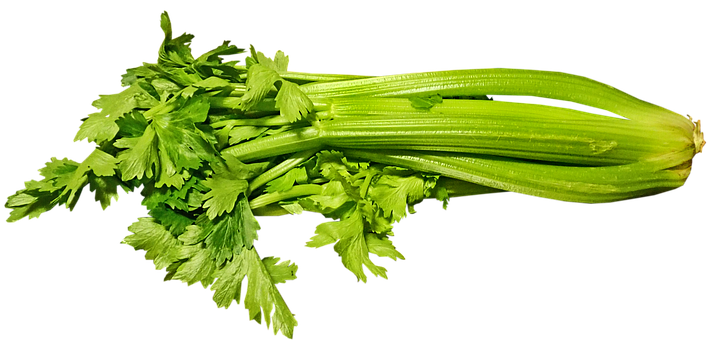
This image has format transparent PNG with resolution 707x340.
You can download this image in best resolution from this page and use it for design and web design.
Celery PNG with transparent background you can download for free, just click on download button.
Celery (Apium graveolens) is a marshland plant in the family Apiaceae that has been cultivated as a vegetable since antiquity. Celery has a long fibrous stalk tapering into leaves. Depending on location and cultivar, either its stalks, leaves or hypocotyl are eaten and used in cooking. Celery seed powder is used as a spice.
Celery leaves are pinnate to bipinnate with rhombic leaflets 3–6 centimetres (1–2+1⁄2 inches) long and 2–4 cm (1–1+1⁄2 in) broad. The flowers are creamy-white, 2–3 mm (3⁄32–1⁄8 in) in diameter, and are produced in dense compound umbels. The seeds are broad ovoid to globose, 1.5–2 mm (1⁄16–5⁄64 in) long and wide. Modern cultivars have been selected for either solid petioles, leaf stalks, or a large hypocotyl.[3] A celery stalk readily separates into "strings" which are bundles of angular collenchyma cells exterior to the vascular bundles.
Wild celery, Apium graveolens var. graveolens, grows to 1 m (3 ft 3 in) tall. Celery is a biennial plant that occurs around the globe. It produces flowers and seeds only during its second year. The first cultivation is thought to have happened in the Mediterranean region, where the natural habitats were salty and wet, or marshy soils near the coast where celery grew in agropyro-rumicion-plant communities.
North of the Alps, wild celery is found only in the foothill zone on soils with some salt content. It prefers moist or wet, nutrient rich, muddy soils. It cannot be found in Austria and is increasingly rare in Germany.
The plants are raised from seed, sown either in a hot bed or in the open garden according to the season of the year, and, after one or two thinnings and transplantings, they are, on attaining a height of 15–20 cm (6–8 in), planted out in deep trenches for convenience of blanching, which is effected by earthing up to exclude light from the stems. Development of self-blanching varieties of celery, which do not need to be earthed up, dominate both the commercial and amateur market.
Celery was first grown as a winter and early spring vegetable. It was considered a cleansing tonic to counter the deficiencies of a winter diet based on salted meats without fresh vegetables. By the 19th century, the season for celery in England had been extended, to last from the beginning of September to late in April.
In this page you can download free PNG images: Celery PNG images free download